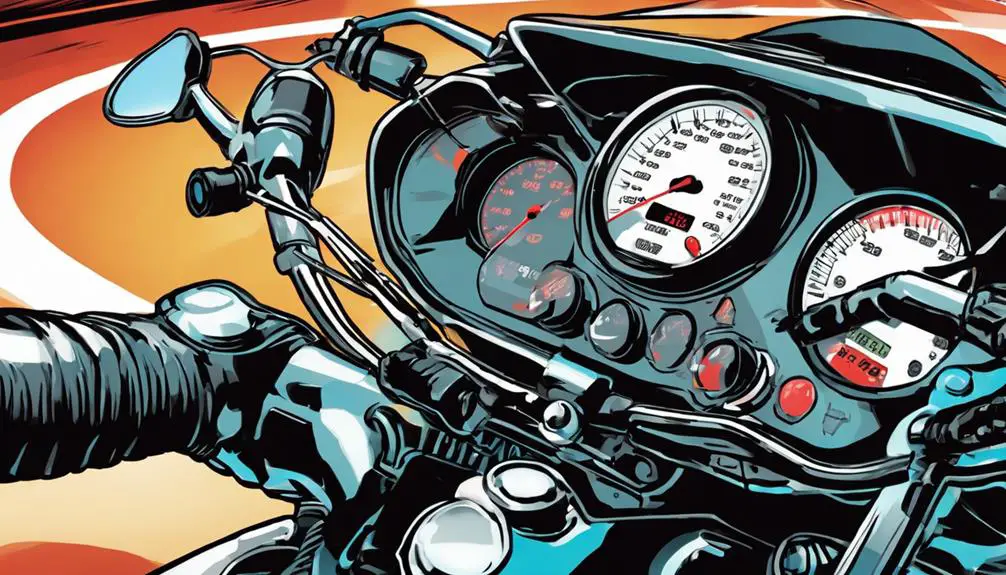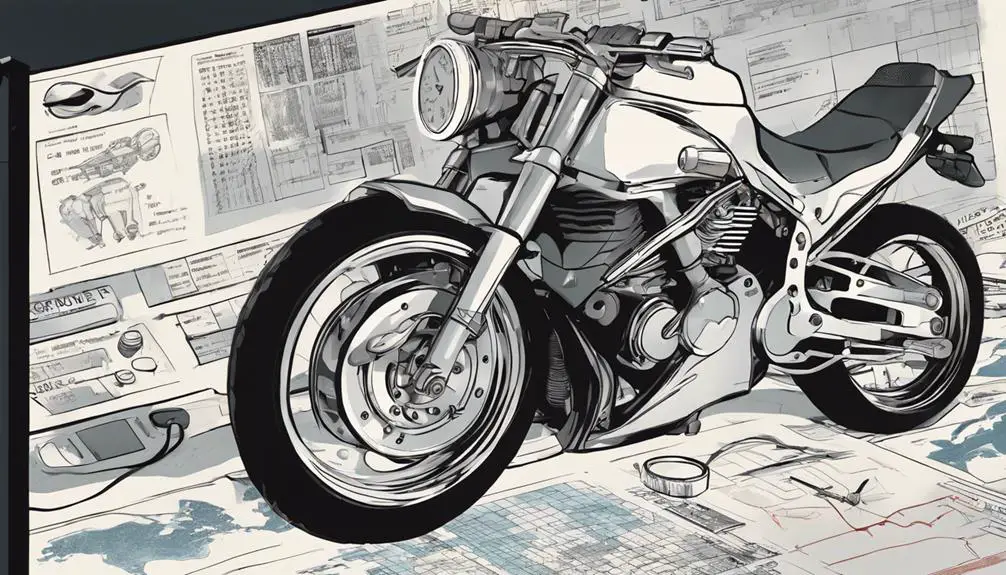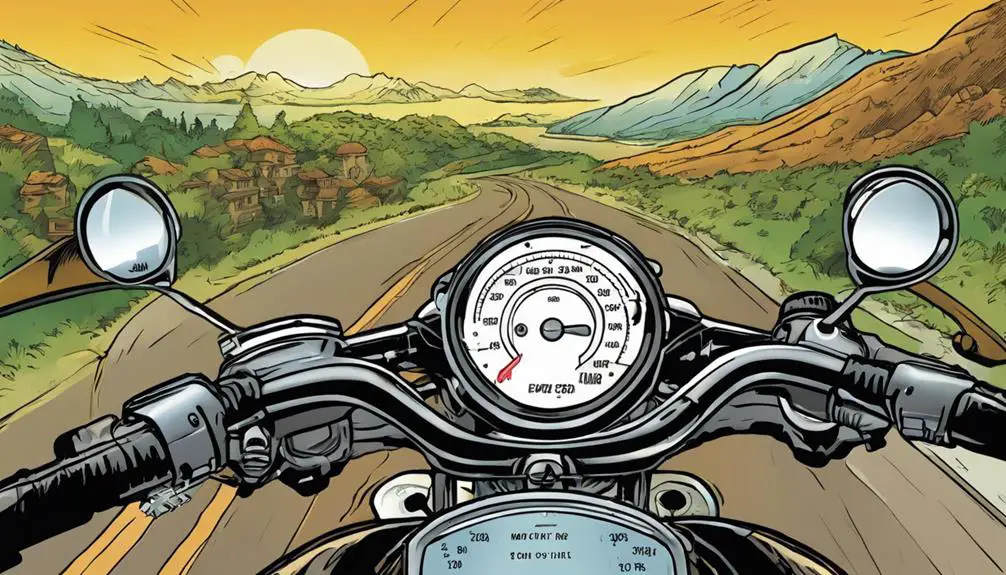When you're torn between the thrill of acceleration and the stability of handling, it's essential to know how to compare motorcycle performance ratings effectively. You might think horsepower is all that matters, but there's much more to take into account. From weight-to-power ratios to braking performance, each element plays a significant role in your riding experience. Understanding these nuances can help you make a choice that suits your needs, but what specific metrics should you focus on to truly gauge performance?
Quick Takeaways
- Evaluate horsepower and torque to understand a motorcycle's power delivery and acceleration capabilities.
- Compare weight-to-power ratios for insights into agility and responsiveness during rides.
- Review engine specifications, including type and displacement, to assess performance suitability for your riding style.
- Analyze fuel efficiency metrics, considering city and highway MPG, to gauge overall running costs.
Understand Performance Metrics

To truly grasp motorcycle performance, you need to know the key metrics that define it. These metrics serve as your compass, guiding you toward the bike that can set you free on the open road.
One of the most vital metrics is horsepower, which reflects how much power your ride generates. Higher horsepower usually means faster acceleration, giving you that exhilarating rush as you twist the throttle.
Torque is another fundamental metric; it tells you how much twisting force the engine produces. This is essential for how your bike feels during everyday rides and when tackling steep hills.
Don't overlook weight-to-power ratio, either. A lighter bike with strong power can offer better agility and responsiveness, making you feel more connected to the machine.
Top speed and acceleration times provide insights into how quickly you can reach your destination, while braking distance metrics reveal how effectively you can stop.
Understanding these performance metrics isn't just about numbers; it's about feeling the wind in your face and the freedom that comes with every ride. Equip yourself with this knowledge, and you'll find the perfect motorcycle to release your spirit.
Analyze Engine Specifications
Engine specifications are the heartbeat of any motorcycle, revealing essential details about performance, efficiency, and overall riding experience. When you explore these specs, you'll uncover what truly makes a bike sing on the open road. Understanding these elements empowers you to choose a motorcycle that aligns with your spirit of freedom.
Here are three key components to analyze:
- Displacement: This measures the size of the engine and directly impacts power output. A larger displacement often translates to more torque and acceleration, giving you that exhilarating rush.
- Type of Engine: Whether it's a single, twin, or four-cylinder, each engine type offers a unique character. Choosing the right one can affect your riding style and the sensations you crave.
- Fuel System: From carburetors to fuel injection, the fuel system influences efficiency and throttle response. A well-tuned system lets you feel every twist of the throttle, enhancing your connection to the machine.
Evaluate Weight and Power Ratio

When you're evaluating a motorcycle's performance, the weight and power ratio plays a vital role.
Understanding how weight distribution affects handling and how power output influences acceleration can greatly impact your riding experience.
Let's break down these factors to see how they contribute to overall performance.
Importance of Weight Distribution
Weight distribution plays an important role in a motorcycle's handling and performance, as it directly influences the weight-to-power ratio and overall stability during acceleration and cornering. When you ride, you'll feel how crucial it's to have that perfect balance, which can make or break your experience on the road.
Here are three key factors to keep in mind regarding weight distribution:
- Front vs. Rear Balance: A well-balanced motorcycle allows for smoother steering and better grip, particularly during sharp turns. Too much weight on the front can lead to understeering, while too much on the rear can cause instability.
- Rider Position: Your weight shifts as you lean into corners or accelerate. Understanding how your position affects the bike's balance can help you maintain control and enhance performance.
- Suspension Setup: The suspension system can affect weight distribution. Fine-tuning it to match your riding style and body weight guarantees ideal contact with the road, giving you confidence and control.
Understanding Power Output
Understanding how weight affects power output helps you evaluate the weight-to-power ratio, which is essential for optimizing motorcycle performance. This ratio, calculated by dividing the bike's weight by its horsepower, gives you a clear picture of how the motorcycle will handle on the road. A lower ratio indicates better acceleration and agility, making your ride feel more liberating.
When you consider power output, think about how it translates into real-world performance. A powerful engine can propel a heavier bike, but the extra weight can hinder speed and maneuverability. Conversely, a lightweight bike with moderate power can feel exhilarating, allowing you to navigate curves and straightaways with ease.
To truly release your riding experience, pay attention to both the horsepower and the overall weight. Aim for a balance that suits your riding style—whether you crave speed on open highways or agility in tight corners.
Consider Suspension and Handling
Good suspension and handling can make a significant difference in your riding experience, enhancing both comfort and control. When you're out on the open road, you want to feel connected to your bike, and the right suspension setup allows you to do just that.
Here are three key factors to take into account:
- Suspension Type: Look for motorcycles with adjustable suspension systems. They let you fine-tune settings based on your weight and riding style, ensuring a balanced ride no matter the terrain.
- Weight Distribution: A well-balanced bike boosts stability and responsiveness. Check how weight is distributed between the front and rear. This balance helps you maneuver with ease, fostering a sense of liberation.
- Handling Characteristics: Evaluate how the bike feels in corners and during quick maneuvers. A responsive steering system allows you to shift your weight effortlessly, giving you confidence to take on twists and turns.
Review Fuel Efficiency Ratings

When you're looking at fuel efficiency ratings, understanding MPG metrics is essential.
It helps you compare different engine types and see how they perform under various riding conditions.
Let's break down these factors to help you make an informed choice.
Understanding MPG Metrics
Fuel efficiency ratings, often measured in miles per gallon (MPG), play an essential role in evaluating a motorcycle's performance and cost-effectiveness. Understanding these metrics helps you make informed decisions that align with your freedom to ride without breaking the bank.
Here are three key points to reflect upon when reviewing MPG ratings:
- City vs. Highway MPG: Motorcycles often have different fuel efficiency ratings for city and highway riding. City riding may yield lower MPG due to frequent stops, while highway riding typically offers better fuel economy. Know where you'll be riding most.
- Rider Behavior: Your riding style can greatly impact fuel efficiency. Aggressive acceleration and high speeds can lead to diminished MPG. Embracing smoother throttle control can extend your range and enhance your riding experience.
- Bike Weight and Engine Size: Lighter bikes with smaller engines often achieve higher MPG. When comparing models, reflect on how weight and engine displacement affect fuel consumption. Balancing power and efficiency can lead you to the perfect ride.
Comparing Engine Types
Understanding the different engine types can greatly influence your motorcycle's fuel efficiency, helping you choose a model that meets your riding needs and preferences.
When you immerse yourself in the world of motorcycles, you'll encounter various engine types, including single-cylinder, parallel-twin, V-twin, and inline-four. Each has its own character and fuel efficiency profile.
Single-cylinder engines often provide decent fuel economy, especially for city riding, but can lack power for longer journeys.
Parallel-twins balance power and efficiency, making them versatile for both commuting and weekend rides. If you crave a deeper rumble and torque, V-twins deliver that, but they may not always be the most fuel-efficient choice.
Inline-four engines, while often powerful and smooth, can consume more fuel, particularly when pushed hard.
Keep in mind that engine displacement and tuning also play a role in fuel efficiency. Smaller engines tend to sip fuel more gently, while larger ones may guzzle it when you tap into their potential.
In your quest for freedom on two wheels, choosing the right engine type tailored to your riding style can enhance your experience and keep your wallet happy.
Analyzing Riding Conditions
Analyzing the impact of riding conditions on fuel efficiency ratings can help you make more informed decisions about your motorcycle choice. Different environments can drastically affect how far you can go on a tank of gas.
Whether you're cruising through city streets or hitting the open highway, understanding these factors can enhance your ride and your freedom.
Here are three key conditions to contemplate:
- Urban vs. Rural Riding: City riding often involves frequent stops and starts, leading to lower fuel efficiency. On the other hand, rural roads typically allow for smoother, continuous travel, enhancing your fuel economy.
- Weather Conditions: Wind resistance and rain can reduce efficiency. Riding against a strong headwind can drain your tank faster than you expect, while wet roads may require more cautious acceleration.
- Altitude Changes: Riding in hilly or mountainous areas can impact your bike's performance. Climbing steep grades demands more power, which can lead to increased fuel consumption.
Examine Braking Performance
Braking performance is essential for rider safety, as it directly impacts how quickly you can stop in emergencies. When you're out on the open road, you want a bike that can respond instantly to your commands. Look for motorcycles equipped with advanced braking systems, such as ABS (Anti-lock Braking System), which prevents wheel lock-up and helps maintain control during hard stops.
Evaluate the brake types—disc brakes typically offer superior stopping power compared to drum brakes. Pay attention to the size and number of discs too; larger discs can dissipate heat more effectively and provide better performance. Don't forget to take into account the materials used; lightweight components can enhance responsiveness.
Test the brakes in various conditions. Find a safe space where you can experience how the motorcycle responds at different speeds. Notice the feel of the lever—does it require little effort to engage, or does it feel spongy? A solid, firm response is what you're after.
Compare User Reviews and Feedback

When considering a motorcycle, diving into user reviews can provide valuable insights into real-world performance and reliability. These reviews often reveal what you won't find in official specs or glossy advertisements.
To help you sift through the noise, here are three key aspects to focus on:
- Performance Feedback: Look for comments on acceleration, handling, and how the bike performs in various conditions. Real riders share experiences that stats alone can't convey.
- Reliability Insights: Users frequently discuss their maintenance experiences and any issues they've faced. This can highlight potential red flags that may affect your long-term satisfaction.
- Comfort and Ergonomics: Comfort is essential for those long rides. Pay attention to feedback regarding seat comfort, riding position, and overall ergonomics to guarantee it fits your body and riding style.
Common Questions
How Do Weather Conditions Affect Motorcycle Performance Ratings?
Weather conditions can greatly impact your motorcycle's performance.
When it's wet, your tires lose grip, and braking distances increase, making handling trickier.
Heat can cause engine overheating, while cold can make your tires stiffer, affecting traction.
Wind can also throw you off balance, especially at high speeds.
Can Aftermarket Parts Impact the Performance Ratings of a Motorcycle?
Absolutely, aftermarket parts can rev up your motorcycle's performance ratings.
By swapping out stock components for high-quality upgrades, you'll release more horsepower and torque, making your ride feel like a rocket on the open road.
Just remember, though, not all aftermarket parts are created equal.
Researching and selecting the right ones guarantees you truly experience that thrilling liberation every rider craves.
What Are the Most Common Performance Issues Reported by Users?
When you plunge into user reports, you'll often find common performance issues like engine stalling, poor acceleration, and braking problems.
Many riders mention inconsistent handling and excessive vibration as well.
You might also notice complaints about fuel efficiency dropping unexpectedly.
These issues can hinder your riding experience, so being aware of them can help you make informed decisions about maintenance or upgrades.
Don't let these problems hold you back from the freedom of the open road!
How Do Different Riding Styles Influence Performance Ratings?
Different riding styles can massively influence performance ratings.
If you ride aggressively, you'll likely push the limits of speed and handling, which can lead to varied ratings based on responsiveness and stability.
On the other hand, if you prefer a more laid-back approach, comfort and fuel economy might take precedence, affecting how the bike is rated overall.
Your personal style shapes not just the ride, but also how you perceive performance.
Are There Specific Brands Known for Better Performance Ratings?
When it comes to brands known for better performance ratings, you've gotta look at those legendary names like Ducati, BMW, and Kawasaki.
These manufacturers often push the envelope with innovative designs and powerful engines.
You'll find that riders rave about their reliability and speed.
If you're craving that sense of liberation on the open road, choosing one of these brands might just be your ticket to freedom.
Wrapping Up
In exploring motorcycle performance ratings, you've likely discovered that it's not just about horsepower or speed.
The truth is, a well-rounded bike balances power, weight, and handling, ensuring a thrilling yet safe ride.
By considering all these factors—from engine specs to user reviews—you can truly gauge a motorcycle's performance.
So, don't just focus on the numbers; dive deeper into the overall experience to find the ride that suits you best.
Happy riding!